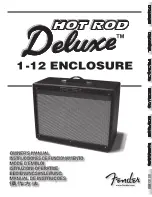
33
Environmental aspects - care and maintenance
In the development of
loudspeakers we concentrate
on innovative solutions to problems, and solid, well
thought-out designs, but these are not our only concerns.
We place equal importance on the maintenan-
ce of all German and European safety norms
and standards.
We are able to guarantee that our products are of the
highest quality, and meet all our specifications in full,
because we carry out strict quality checking of all materi-
als, employ painstaking production methods controlled
by highly qualified staff, and carry out a fully automatic,
computer-controlled final quality control procedure.
At the earliest stage of development we also emphasise
the importance of avoiding environmentally harmful ma-
terials and methods of working.
For example, we avoid the use of materials which are
injurious to health, such as chlorine-based solvents and
CFCs.
We also aim to avoid the use of plastics in general, and
PVC in particular, in the design of our products.
Instead we rely upon metals and other non-hazardous
materials which are easy to recycle.
Electronic sub-assemblies such as valve output stages
are shielded by solid metal housings.
This excludes any possibility of external sources of in-
terference affecting the quality of reproduction. From the
opposite point of view our products’ electro-magnetic
radiation (electro-smog) is reduced to an absolute mini-
mum.
The particle board which we use meets the E1 quality
standard in full. The board is manufactured without the
use of chlorides, other halogens and timber preservative,
and its formaldehyde content is checked at regular inter-
vals by independent monitoring laboratories.
In ecological terms particle board is environmentally
sound, because its use represents a significant ecologi-
cal use of wood as a renewable raw material.
The sound-absorbent wadding used in our loudspeakers
is made of 100 % polyester fibres, in conjunction with a
binding fibre.
This material has been tested for harmful ingredients to
Eco-Tex Standard 100
; the same test is used for
clothing, bedclothes, pillows, mattresses, household
textiles etc.
The wadding we use has passed the „
textiles tested for
harmful materials
“ test and fulfils the currently valid
humane-ecological requirements. It has even success-
fully met the very exacting requirements of the standard
test for baby clothing.
For loudspeaker transport we have selected a form of
styrofoam packing which gives excellent protection and
is environmentally non-harmful, because:
-
Styrofoam is not foamed using CFC-based propellants,
but with pentane, which is a pure hydro-carbon.
-
Styrofoam packaging is 100 % recyclable; it can be
disposed of, free of charge, at material collection
centres and community recycling points.
-
Styrofoam packaging requires for its manufacture 85 %
less raw material and 50 % less energy than compa-
rable packaging made from other materials.
-
Styrofoam packaging consists of up to 98 % air, and
2 % pure hydro-carbon.
-
Styrofoam packaging has no harmful effect on ground
water.
-
Styrofoam packaging helps to reduce freight costs and
transport damage.
Note:
The carton containing the styrofoam packaging has been
designed specifically for our loudspeakers.
It forms a safe container if you ever need to transport the
speakers, and helps to maintain their resale value.
Care and maintenance:
The surface of the loudspeaker cabinets should be clea-
ned simply by wiping with a soft, dry cloth.
Never use powerful cleaning agents or solvent cleaners!
If necessary, the front grille can also be cleaned carefully
using a vacuum cleaner.
Please note that the drive units of some loudspeaker
models are mounted immediately behind the cover, so
don’t press too hard on them with the vacuum cleaner,
otherwise you could damage the delicate loudspeaker
chassis.
Loudspeaker cabinets finished in genuine hardwood
veneers should be set up in a location away from direct
sunshine; real wood changes colour when subjected to
sunlight.
The only permissible method of disposing of
this product is to take it to your local collec-
tion centre for electrical waste.
All manuals and user guides at all-guides.com




































